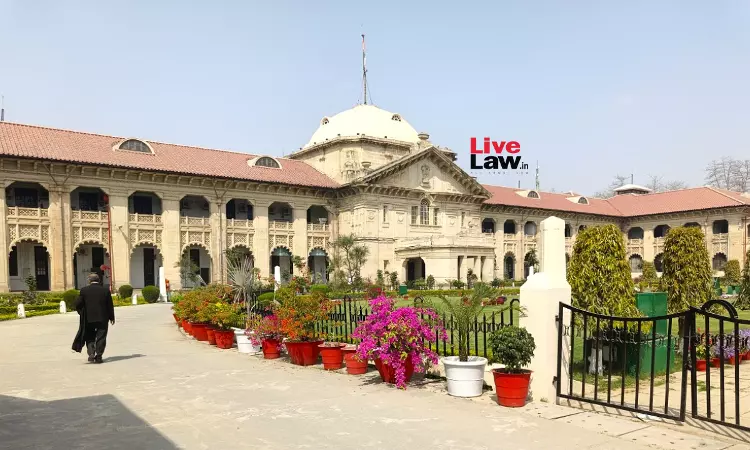- Home
- /
- High Courts
- /
- Allahabad High Court
- /
- Absence Of Upward Injury Marks On...
Absence Of Upward Injury Marks On Deceased Leads Allahabad High Court To Acquit Sole Surviving Accused In 1984 Murder Case
Sparsh Upadhyay
3 Oct 2025 11:21 AM IST
The Allahabad High Court recently acquitted a man in connection with a nearly four-decade-old murder case as it opined that the prosecution had failed to establish its case beyond reasonable doubt. In its appreciation of evidence against the sole surviving accused, a Bench of Justice Vivek Kumar Birla and Justice Jitendra Kumar Sinha found that the firearm injuries on the deceased...
The Allahabad High Court recently acquitted a man in connection with a nearly four-decade-old murder case as it opined that the prosecution had failed to establish its case beyond reasonable doubt.
In its appreciation of evidence against the sole surviving accused, a Bench of Justice Vivek Kumar Birla and Justice Jitendra Kumar Sinha found that the firearm injuries on the deceased did not show any upward direction, which would have been expected if shots were fired at him (by the accused standing on ground) while the deceased sat on the driver's seat of a tractor.
This inconsistency, along with the unnatural conduct of alleged eye-witnesses and unexplained injuries, led the Court to extend the benefit of doubt to the surviving accused and thus, he was acquitted.
The court was essentially dealing with an appeal filed by 5 accused who had been convicted by the Sessions Court in 1986 under Sections 302/149 IPC and 148 IPC for the murder of one Charan Singh.
During the pendency of the criminal appeal, appellant no.1 (Harswarup), appellant no. 3 (Jawahar), appellant no. 4 (Tulsi) and appellant no. 5 (Bhagat Singh) passed away. Thus, the appeal survived only in respect of appellant no. 2 (Suresh).
Prosecution's Case
According to the FIR lodged on 17 September 1984, Charan Singh was ploughing his field with a tractor when six men, including his brothers and nephew, with whom he had a prior land dispute, arrived armed with guns, country-made pistols and a spear.
The FIR alleged that they assaulted the deceased and the informant by opening fire with their country-made pistol, gun and by ballam (spear). This resulted in the death of Charan Singh, however, his brother (informant) escaped unhurt.
The trial court in Mathura convicted the accused in 1986 and sentencing them to life imprisonment. An appeal against the judgement was filed in 1986.
Arguments
Sole surviving accused denied his involvement in the matter as his counsel argued that he had been falsely implicated in the case owing to enmity and family disputes over land and tractor loan repayments.
It was also contended that the prosecution story was inconsistent with the post mortem report of the deceased which revealed firearm injuries without any upward trajectory which is inconsistent with the prosecution's version that the deceased was shot while seated high on a tractor.
In other words, it was strongly argued that if prosecution's version is supposed truthful, in that event, the direction of the fire arm injuries received by the deceased should have been upward, however, in the instant case, all the fire arm injuries on the dead body were straight injuries.
It was also submitted that the prosecution alleged that the deceased was ploughing the field by tractor where he was assaulted by all the accused persons, but, he argued, these injuries cannot be possible to be sustained by the deceased while he was sitting on the driver seat of the tractor.
It was further argued that the deceased had old enmities in the village, including with Mohan Lal, who had been convicted earlier for the murder of Charan Singh's father and released after serving his sentence and even he could have committed his murder.
Court's Observations
In its appreciation of the evidence and taking into account the defence arguments, the Court found force in the submissions of the defence as it observed thus:
"From the injuries received by the deceased the direction of none of the injuries is upward and we find force in the submissions of the learned counsel for the applicant that when the deceased was sitting on the driving seat of the tractor and accused persons are said to have opened fire from the ground level by their respective weapons, the direction of the wound must have been upward, that is not so, therefore the prosecution case on this point appears to be inconsistent".
The Court also took referred to the unnatural behavior of P.W. 3, P.W. 4, and P.W. 6, all relatives of the deceased, in not touching or removing the body, which the court said, rendered their presence at the scene 'highly doubtful'.
The Court also noted that there had been an unexplained incised wounds and absence of empty cartridges or firearm marks on the tractor which added to the inconsistencies of the prosecution's case.
The Court also observed that while eye witnesses P.W. 3, 4 and 6 stated that no blood fell on the soil, the IO collected the blood-strained soil, which, the court found, made the prosecution story inconsistent.
"Moreover the dimension and size of the injuries received by the deceased also does not correspond to the eye witnesses account as there is no upward mark of fire arm injury on the person of the deceased. It is the defence case that Mohan Lal was convicted for the murder of the father of the deceased and he had spent considerable time in the jail and he had come out and therefore it is quite possible that murder of the deceased could have been committed by the said Mohan Lal", the Court further noted.
Therefore, it concluded that the prosecution had failed to prove guilt beyond reasonable doubt. The Court thus acquitted Suresh by setting aside the conviction and sentence.
Case title - Har Swaroop vs. State
Case citation :



